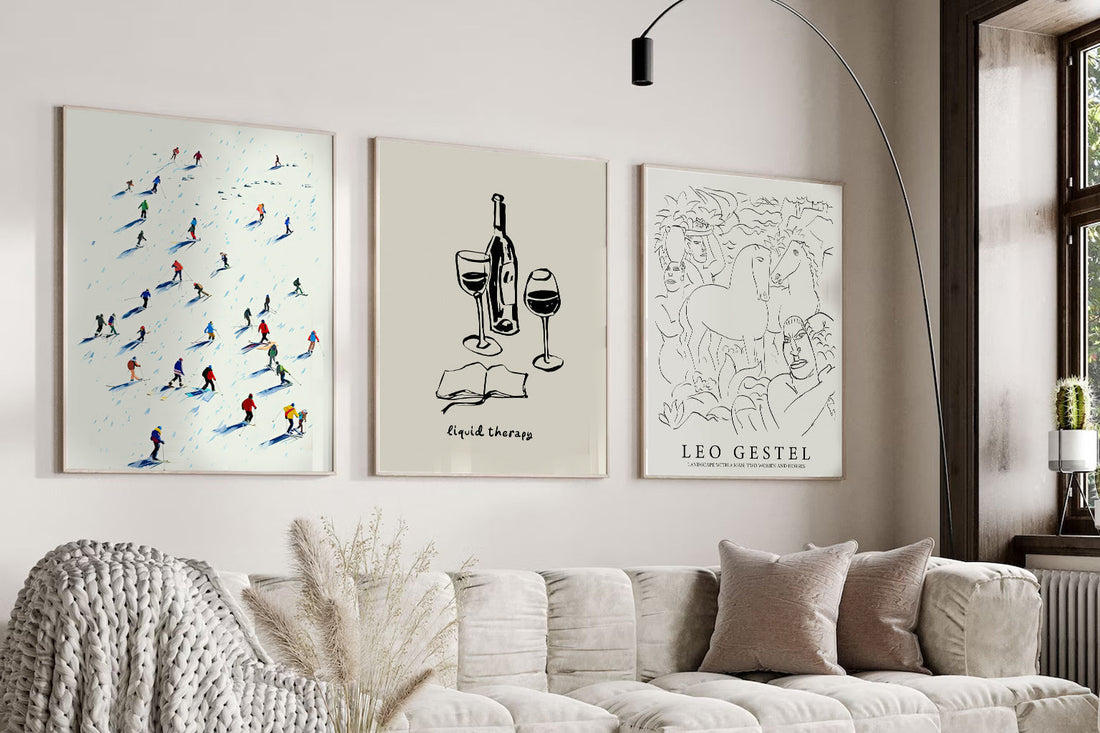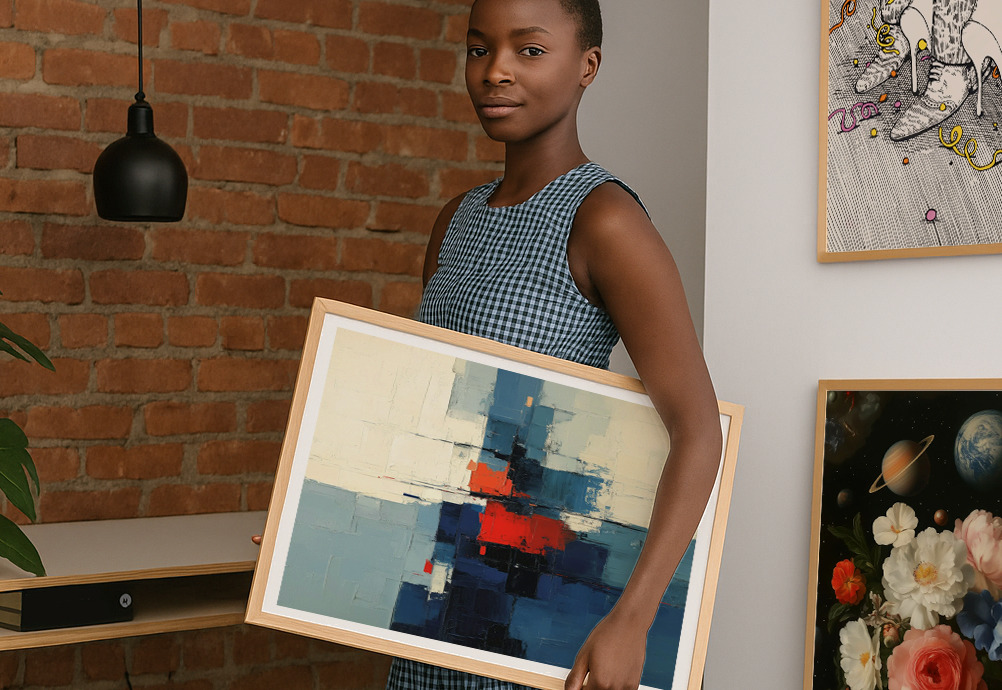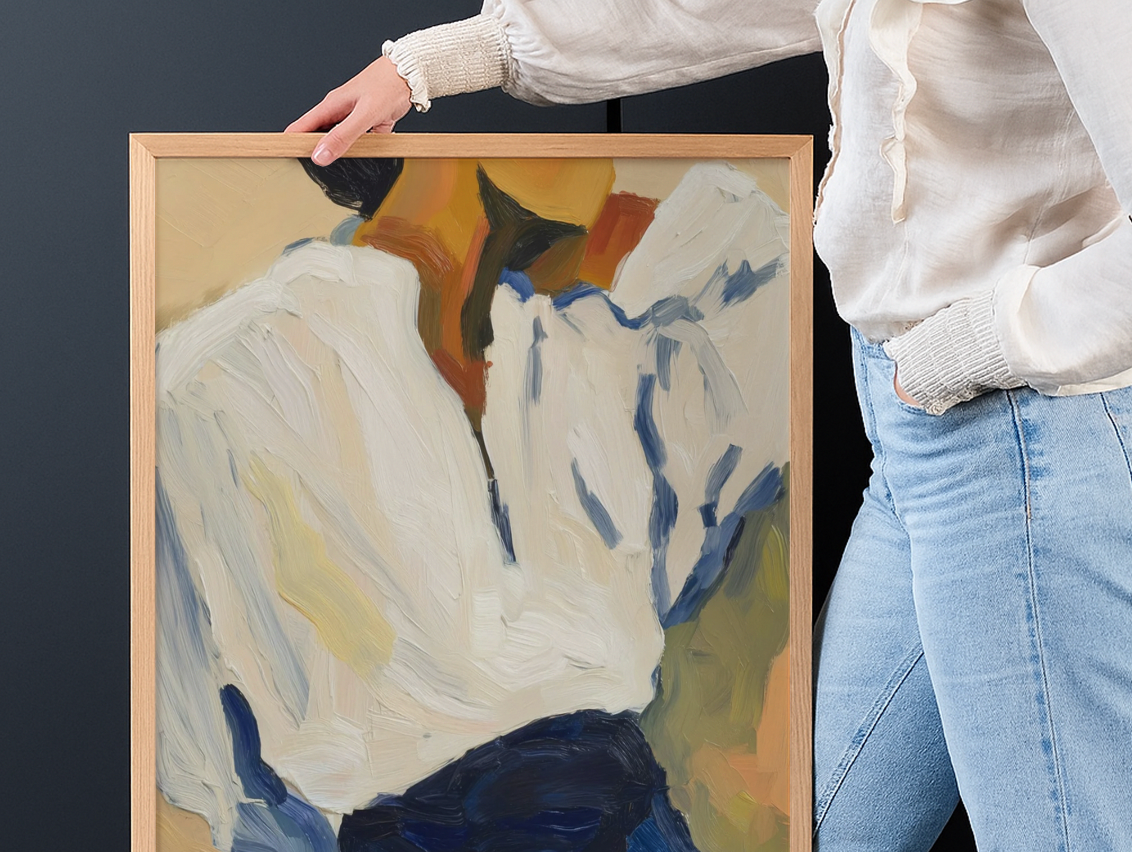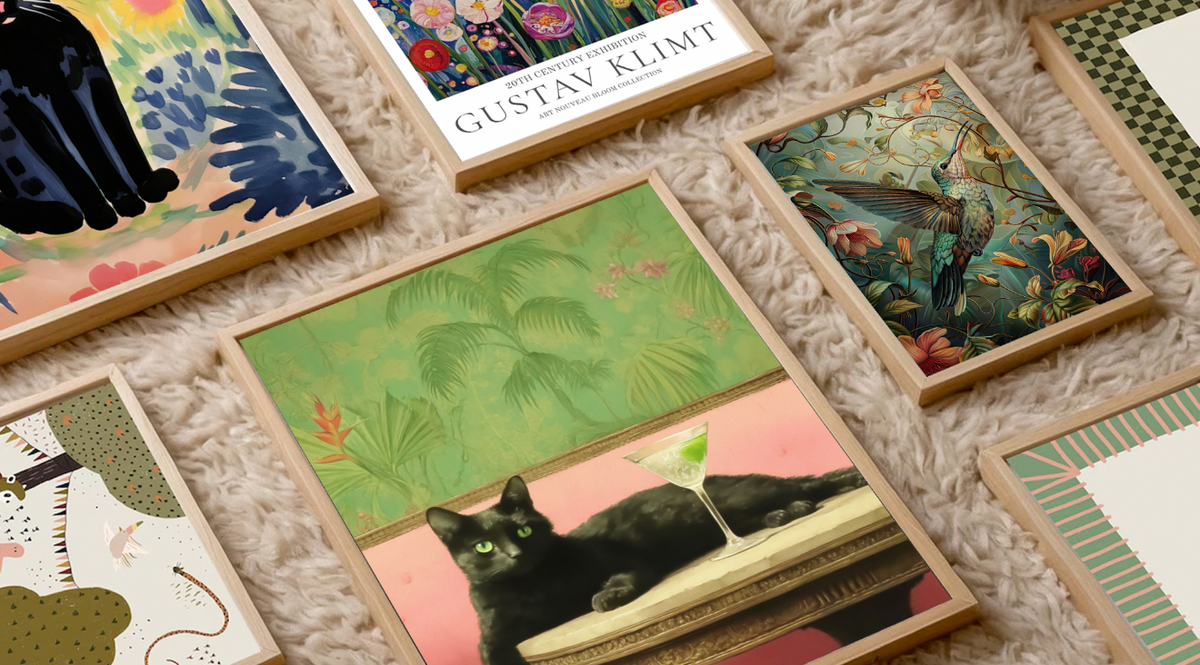Minimalism, But Not Boring: Subtle Prints with Power
Muted tones, clean lines, and quiet compositions - but with real presence.

Minimalist art gets a bad reputation. People think it means blank walls, beige everything, and spaces that feel more like waiting rooms than homes.
But real minimalist prints aren't about emptiness. They're about intention. Every line, every shape, every patch of negative space is there for a reason.
The best minimal art doesn't whisper. It speaks clearly, just without raising its voice.
What minimalist really means
Minimalism isn't about using fewer colors or simpler shapes just for the sake of it. It's about distilling an idea down to its most essential form.
Think about a single brushstroke of charcoal on cream paper. That mark can suggest movement, emotion, or energy without needing anything else around it. Or consider a photograph of smooth stones balanced on each other. The composition creates calm, but there's tension in that balance too.
These pieces work because they give your eye somewhere to rest while still offering something to think about. They don't demand attention, but they reward it when you give it.
The power of restraint
There's something compelling about art that holds back. A line drawing that suggests a figure with just a few curves. An abstract composition that uses only two colors but creates depth anyway.
This restraint can be more powerful than complexity. When you strip away everything non-essential, what remains has to work harder. Every element becomes important.
A soft grey curve can balance an entire room. A single vertical line can make a ceiling feel taller. Negative space can create tension and movement without adding visual noise.
Texture matters more than you think
In minimalist art, texture often does the heavy lifting that color or complexity might do in other styles. A print that looks simple from across the room might reveal subtle variations up close.
Paper texture, printing techniques, and even the way ink sits on a surface can add layers of interest without adding visual clutter. A print with a slightly rough, handmade feel brings warmth to a clean space. Smooth, precise lines create a different kind of energy.
This is why framed vs unframed art: what's right for you? becomes especially important with minimal pieces. The frame can either support the clean aesthetic or work against it.
Scale creates impact
One of the most effective ways to make minimalist art feel powerful is to go larger than expected. A single, substantial piece can anchor a room in ways that multiple smaller prints can't.
What size art do I need for this wall? covers the technical aspects, but with minimalist pieces, you often want to err on the side of larger. The simplicity of the composition can handle the scale, and the increased size gives the subtle elements more room to breathe.
A large print with mostly white space doesn't feel empty. It feels expansive. The negative space becomes an active part of the composition rather than just background.

Different styles of minimal
Not all minimalist art looks the same. There are several approaches, each with its own personality.
Japanese-inspired prints embrace asymmetry and natural forms. Think ink paintings of bamboo or mountains, where the composition feels balanced but not symmetrical. These bring a sense of calm and natural beauty without being literal about it.
Line art reduces subjects to their essential contours. A face drawn with continuous lines, a plant reduced to its basic shape. These prints feel modern and sophisticated while still being recognizable and approachable.
Typographic pieces use words as visual elements. Clean fonts, thoughtful spacing, maybe a single meaningful phrase. These work especially well in offices or reading areas where the content adds an extra layer of purpose.
Soft-toned abstracts use color more subtly. Gentle gradients, muted palettes, shapes that suggest rather than define. These can add warmth and emotion to a space without overwhelming it.
Styling minimal prints
The beauty of minimalist art is how well it plays with other elements in a room. It doesn't compete for attention, so you can layer in texture and interest through furniture, textiles, and lighting.
Minimal prints work beautifully with neutral interiors, but they don't require them. A simple black and white print can actually look stunning against a colored wall, creating contrast without chaos.
Layered textiles become more important when your art is restrained. Interesting throws, varied pillow textures, or a rich rug can provide the tactile interest that the art deliberately avoids.
Sculptural lighting pairs particularly well with minimal art. Both elements can be simple and clean while still having strong visual presence. They complement each other rather than competing.
Wall Art by Style: A Guide to Every Aesthetic explores how minimalist pieces fit into different interior approaches, but they're particularly versatile because they don't impose a specific mood on a space.
When minimal works best
Minimalist prints excel in spaces where you want calm, focus, or sophistication. Bedrooms benefit from the peaceful energy. Home offices appreciate the lack of distraction. Living areas use minimal art to create breathing room.
But minimal doesn't always mean calm. A bold geometric shape in black and white can feel energizing. A single dramatic line can create movement and excitement. The key is that the impact comes from the composition and placement rather than from busy details or bright colors.
Find Your Art Style: Minimalist, Maximalist, or Boho? can help you determine if this approach fits your personality, but remember that you don't have to commit to one style throughout your home.
Common minimal mistakes
The biggest mistake with minimalist art is thinking that simpler always means better. Not every basic line drawing or monochrome print has the thoughtful composition that makes minimalism powerful.
Look for pieces where the negative space feels intentional, not accidental. Where the lines or shapes create interesting relationships with each other. Where the composition would lose something important if you removed or changed any element.
Another mistake is hanging minimal prints too small. These pieces often need room to breathe and space to create their impact. A tiny minimal print on a large wall just looks lost.

Creating collections
Minimalist prints can work beautifully in multiples, but the approach is different from other styles. Instead of creating visual complexity through variety, you're creating rhythm and relationship through repetition and subtle variation.
Three line drawings with similar sensibilities but different subjects. A series of abstract compositions in the same color family. Multiple photographs with consistent mood but different textures.
The key is restraint in the grouping as well as the individual pieces. Let each print have space, and choose arrangements that feel calm rather than busy.
Quality and minimal art
With minimalist prints, quality becomes especially important because there's nowhere to hide. Every line, every texture, every color choice is visible and significant.
Poor printing or cheap materials become obvious when there aren't complex details to distract from them. The simplicity of the composition means that subtle variations in color, sharpness, or paper quality have a bigger impact on the final result.
The emotional impact
Good minimalist art doesn't feel cold or empty. It feels intentional and peaceful. There's something deeply satisfying about looking at a composition that feels perfectly balanced, where nothing needs to be added or taken away.
This emotional response is what separates effective minimal art from pieces that are just simple. The best minimal prints create a sense of completion and calm that makes a space feel more settled and thoughtful.
How To Use Art To Make a Room Feel Complete explores this concept further, but minimal art has a particular gift for creating that sense of wholeness without overwhelming a space.
Finding your minimal style
Not everyone responds to the same type of minimalism. Some people are drawn to organic, flowing lines. Others prefer geometric precision. Some want complete abstraction, while others like simplified representations of recognizable subjects.
The key is finding minimal art that resonates with your particular sense of beauty and calm. A piece might be simple, but it should still move you in some way. It should make you feel something, even if that feeling is peace or satisfaction rather than excitement.

Making minimal feel warm
One concern people have about minimalist art is that it might make their space feel cold or unwelcoming. But minimal doesn't have to mean sterile.
Choose pieces with subtle warmth in the colors, even if they're muted. Look for textures that suggest handmade quality rather than machine precision. Consider compositions that include organic shapes alongside geometric ones.
The rest of your room plays a role too. Minimal art works beautifully with warm woods, soft textiles, and natural light. The restraint in the art can actually make these other elements feel more luxurious and important.
Ready to explore minimalist art that speaks quietly but clearly? Browse Minimalist Prints and find pieces that bring calm clarity to your space.
Fab products featured in this blog
-
LEER (Kopie) (Kopie)
Ab €16,95 -
LEER (Kopie) (Kopie)
Ab €16,95 -
LEER (Kopie) (Kopie)
Ab €16,95 -
LEER (Kopie) (Kopie)
Ab €16,95 -
LEER (Kopie) (Kopie)
Ab €16,95 -
LEER (Kopie) (Kopie)
Ab €16,95 -
LEER (Kopie) (Kopie)
Ab €16,95 -
LEER (Kopie) (Kopie)
Ab €16,95 -
Poster botanische Linienzeichnung
Ab €16,95 -
Rearing Horse by Leo Gestel Art Print
Ab €16,95 -
LEER (Kopie) (Kopie)
Ab €16,95
More from The Frame
More stories, insights, and behind-the-scenes looks at the art that transforms your space.
Top Wall Art Trends for 2025: What's In, What's...
Trends aren't rules to follow blindly. They're signals about where our collective taste is heading, what's capturing our imagination, and what feels fresh right now. The wall art trending in...
Art for Gifting: How to Choose a Print for Some...
Giving someone art is either incredibly thoughtful or slightly terrifying. There's no middle ground. On one hand, you're giving them something beautiful that will live in their home for years....
9 Art Prints That Instantly Elevate Any Living ...
You know that feeling when you walk into a beautifully styled living room and everything just feels right? It's not the expensive sofa or the perfect rug. It's usually the...















